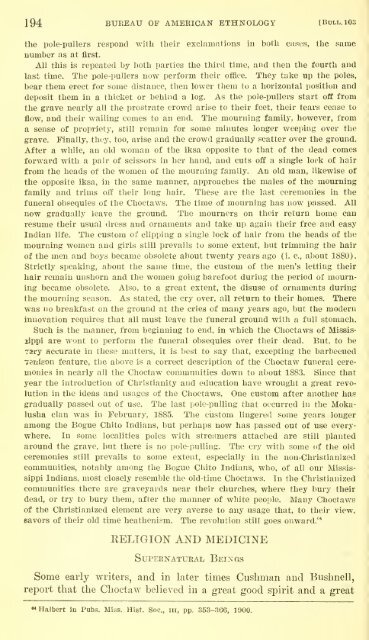siOBX; - Smithsonian Institution
siOBX; - Smithsonian Institution
siOBX; - Smithsonian Institution
You also want an ePaper? Increase the reach of your titles
YUMPU automatically turns print PDFs into web optimized ePapers that Google loves.
194 BUREAU OF AMERICAN ETHNOLOGY [BtJLL.103<br />
the pole-pullers respond with their exclamations in both cases, the same<br />
number as at first.<br />
All this is repeated by both parties the third time, and then the fourth and<br />
last time. The pole-pullers now perform their office. They take up the poles,<br />
bear them erect for some distance, then lower them to a horizontal position and<br />
deposit them in a thicket or behind a log. As the pole-pullers start off from<br />
the grave nearly all the prostrate crowd arise to their feet, their tears cease to<br />
flow, and their wailing comes to an end. The mourning family, however, from<br />
a sense of propriety, still remain for some minutes longer weeping over the<br />
grave. Finally, they, too, arise and the crowd gradually scatter over the ground.<br />
After a while, an old woman of the iksa opposite to that of the dead comes<br />
forward with a pair of scissors in her hand, and cuts off a single lock of hair<br />
from the heads of the women of the mourning family. An old man, likewise of<br />
the opposite iksa, in the same manner, approaches the males of the mourning<br />
family and trims off their long hair. These are the last ceremonies in the<br />
funeral obsequies of the Choctaws. The time of mourning has now passed. All<br />
now gradually leave the ground. The mourners on their return home can<br />
resume their usual dress and ornaments and take up again their free and easy<br />
Indian life. The custom of clipping a single lock of hair from the heads of the<br />
mourning women and girls still prevails to some extent, but trimming the hair<br />
of the men and boys became obsolete about twenty years ago (i. e., about 1880).<br />
Strictly speaking, about the same time, the custom of the men's letting their<br />
hair remain unshorn and the women going barefoot during the period of mourning<br />
became obsolete. Also, to a great extent, the disuse of ornaments during<br />
the mourning season. As stated, the cry over, all return to their homes. There<br />
was no breakfast on the ground at the cries of many years ago, but the modern<br />
innovation requires that all must leave the funeral ground with a full stomach.<br />
Such is the manner, from beginning to end, in which the Choctaws of Missis-<br />
lippi are wont to perform the funeral obsequies over their dead. But, to be<br />
rary accurate in these matters, it is best to say that, excepting the barbecued<br />
"snlson feature, the above is a correct description of the Choctaw funeral ceremonies<br />
in nearly all the Choctaw communities down to about 1883. Since that<br />
year the introduction of Christianity and education have wrought a great revolution<br />
in tlie ideas and usages of the Choctaws. One custom after another has<br />
gradually passed out of use. The last pole-pulling that occurred in the Moka-<br />
lusha clan was in February, 1885. The custom lingered some years longer<br />
among the Bogue Chito Indians, but perhaps now has passed out of use everywhere.<br />
In some localities poles with streamers attached are still planted<br />
around the grave, but there is no pole-pulling. The cry with some of the old<br />
ceremonies still prevails to some extent, especially in the non-Christianized<br />
communities, notably among the Bogue Chito Indians, who, of all our Missis-<br />
sippi Indians, most closely resemble the old-time Choctaws. In the Christianized<br />
communities there are graveyards near their churches, where they bury their<br />
dead, or try to bury them, after the manner of white people. Many Choctaws<br />
of the Christianized element are very averse to any usage that, to their view,<br />
savors of their old time heatheni.sm. The revolution still goes onward.'^<br />
RELIGION AND MEDICINE<br />
Supernatural Bei^^gs<br />
Some early writers, and in later times Cushman and Bushnell,<br />
report that the Choctaw believed in a great good spirit and a great<br />
«»Halbert in Pubs. Miss. Hist. Soc, iii, pp. 353-.S66, 1900.

















